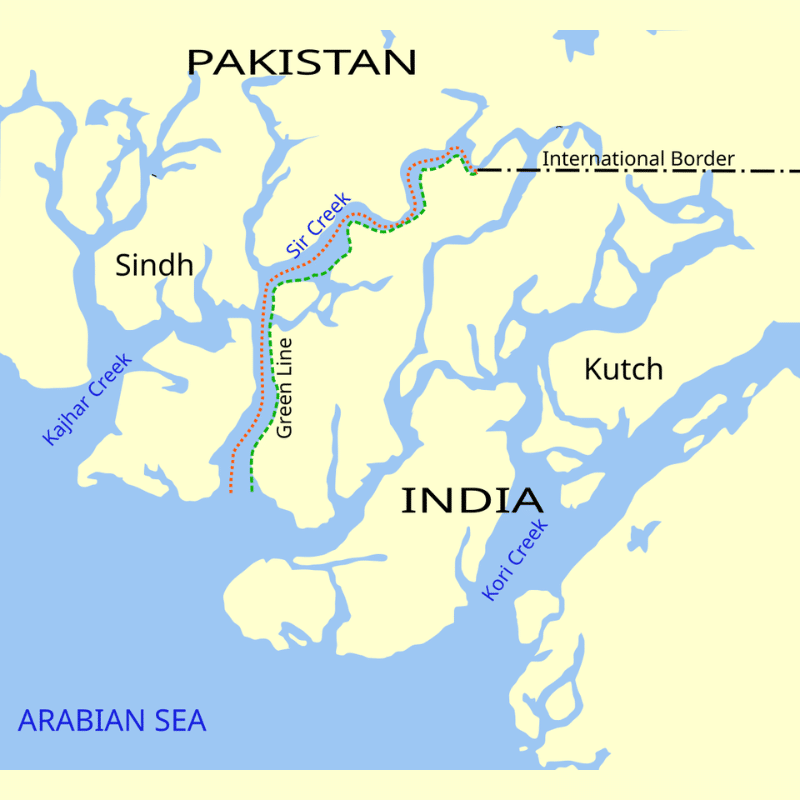
The Sir Creek dispute between India and Pakistan is one of the lesser-discussed yet strategically significant territorial disagreements between the two neighbours. While overshadowed by larger conflicts such as Kashmir, the dispute has persisted since the colonial era, carrying implications for security, economics, and ecology. Read here to learn more.
India’s Defence Minister recently warned that any aggressive action by Pakistan in the Sir Creek area would be met with a firm response, underlining India’s vigilance in one of the most sensitive and unresolved border regions.
Historical Background
- Pre-Independence Roots
- The dispute can be traced back to 1908, when disagreements arose between the Rao of Kutch and the Sindh government over firewood collection in the creek area.
- To settle the issue, the Bombay Government Resolution of 1914 was issued, but it contained contradictory provisions:
- Paragraph 9: Suggested the boundary lies on the eastern bank, effectively granting the creek to Sindh (now Pakistan).
- Paragraph 10: Applied the Thalweg Principle, holding that since Sir Creek is navigable most of the year, the mid-channel should serve as the boundary.
- Post-Independence Dispute
- After 1947, Kutch went to India, and Sindh to Pakistan.
- India considers Para 10 binding, supported by the 1925 map and 1924 mid-channel boundary pillars.
- Pakistan, however, emphasizes Para 9 and denies navigability, rejecting the Thalweg principle.
What is Sir Creek?

- Geography: A 96-kilometre-long tidal estuary in the marshlands of the Rann of Kutch, Gujarat, forming part of the boundary between India’s Kutch region and Pakistan’s Sindh province, before opening into the Arabian Sea.
- History: Historically called Ban Ganga, it was renamed “Sir Creek” during the British era after a colonial official.
- Dispute Origin: After 1947, Kutch became part of India and Sindh of Pakistan. The disagreement arises from different interpretations of a 1914 resolution on the maritime boundary.
India and Pakistan’s Claims
- India’s Position:
- Cites the thalweg principle (international law standard that the boundary lies along the middle of a navigable channel).
- Argues Sir Creek is navigable during high tide and thus qualifies for the thalweg principle.
- References a 1925 map and mid-channel boundary pillars supporting this claim.
- Pakistan’s Position:
- Claims the entire creek, citing the 1914 resolution.
- Rejects the thalweg principle, arguing it applies only to rivers, not creeks, and contends Sir Creek is non-navigable.
Why is Sir Creek Important?
- Strategic Significance:
- A critical border zone with a history of skirmishes and infiltration.
- Control over the creek determines maritime boundaries, impacting surveillance, naval operations, and national security.
- Economic Value:
- One of Asia’s richest fishing grounds, sustaining thousands of fishermen from both sides.
- The seabed may hold oil and gas reserves, adding to its economic importance.
- Ecological Importance:
- The creek and its surrounding wetlands host migratory birds such as flamingoes, making it an ecologically sensitive biodiversity hotspot.
Attempts at Resolution
- 1965 War and Aftermath: The Rann of Kutch tribunal (1968) awarded Pakistan only 10% of its claims.
- Composite Dialogue (1997): The issue was discussed as part of broader peace talks.
- 1999: Tensions escalated when India shot down a Pakistani surveillance aircraft near the creek.
- 2005–07: Joint surveys were conducted to map the area, but no resolution followed.
Despite repeated discussions, no agreement has been reached due to conflicting legal interpretations and a lack of political trust.
Way Forward
- Humanitarian Angle: Fishermen from both nations are routinely arrested for crossing unmarked maritime boundaries. A settlement could ease their suffering.
- Economic Opportunities: Resolution would enable oil and gas exploration and stabilize fishing rights.
- Low-Hanging Fruit: Compared to Kashmir, Sir Creek is seen as a less contentious issue, making it a potential confidence-building measure between India and Pakistan.
Conclusion
The Sir Creek dispute goes beyond a cartographic disagreement; it intertwines security, economic, and ecological stakes. As both India and Pakistan continue to assert their claims, the region remains a flashpoint. India’s recent strong stance indicates that it sees the dispute not only as a boundary issue but also as a matter of strategic deterrence and coastal security.
Related articles:






Leave a Reply